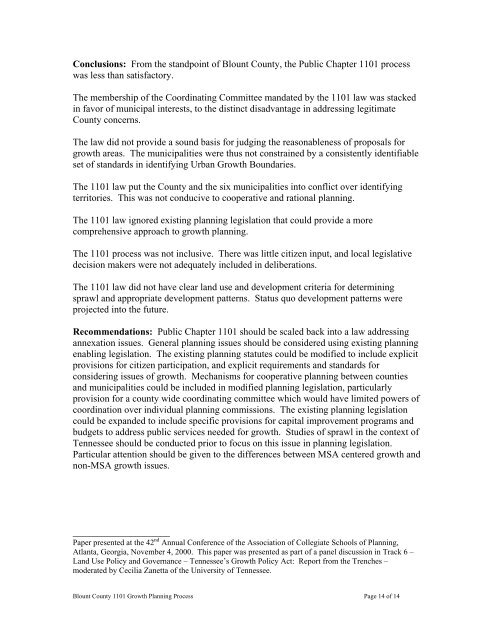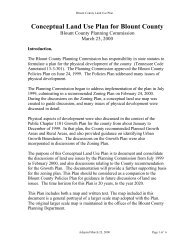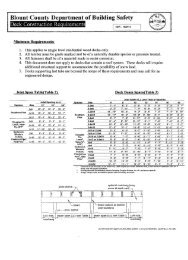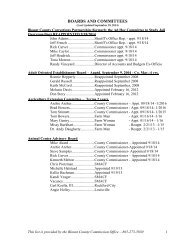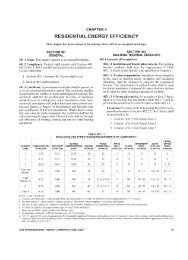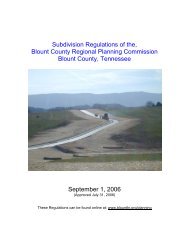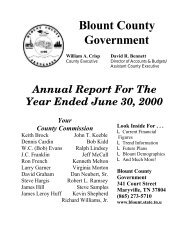Reflections on the 1101 Process in Blount County, Tennessee
Reflections on the 1101 Process in Blount County, Tennessee
Reflections on the 1101 Process in Blount County, Tennessee
Create successful ePaper yourself
Turn your PDF publications into a flip-book with our unique Google optimized e-Paper software.
C<strong>on</strong>clusi<strong>on</strong>s: From <strong>the</strong> standpo<strong>in</strong>t of <strong>Blount</strong> <strong>County</strong>, <strong>the</strong> Public Chapter <strong>1101</strong> processwas less than satisfactory.The membership of <strong>the</strong> Coord<strong>in</strong>at<strong>in</strong>g Committee mandated by <strong>the</strong> <strong>1101</strong> law was stacked<strong>in</strong> favor of municipal <strong>in</strong>terests, to <strong>the</strong> dist<strong>in</strong>ct disadvantage <strong>in</strong> address<strong>in</strong>g legitimate<strong>County</strong> c<strong>on</strong>cerns.The law did not provide a sound basis for judg<strong>in</strong>g <strong>the</strong> reas<strong>on</strong>ableness of proposals forgrowth areas. The municipalities were thus not c<strong>on</strong>stra<strong>in</strong>ed by a c<strong>on</strong>sistently identifiableset of standards <strong>in</strong> identify<strong>in</strong>g Urban Growth Boundaries.The <strong>1101</strong> law put <strong>the</strong> <strong>County</strong> and <strong>the</strong> six municipalities <strong>in</strong>to c<strong>on</strong>flict over identify<strong>in</strong>gterritories. This was not c<strong>on</strong>ducive to cooperative and rati<strong>on</strong>al plann<strong>in</strong>g.The <strong>1101</strong> law ignored exist<strong>in</strong>g plann<strong>in</strong>g legislati<strong>on</strong> that could provide a morecomprehensive approach to growth plann<strong>in</strong>g.The <strong>1101</strong> process was not <strong>in</strong>clusive. There was little citizen <strong>in</strong>put, and local legislativedecisi<strong>on</strong> makers were not adequately <strong>in</strong>cluded <strong>in</strong> deliberati<strong>on</strong>s.The <strong>1101</strong> law did not have clear land use and development criteria for determ<strong>in</strong><strong>in</strong>gsprawl and appropriate development patterns. Status quo development patterns wereprojected <strong>in</strong>to <strong>the</strong> future.Recommendati<strong>on</strong>s: Public Chapter <strong>1101</strong> should be scaled back <strong>in</strong>to a law address<strong>in</strong>gannexati<strong>on</strong> issues. General plann<strong>in</strong>g issues should be c<strong>on</strong>sidered us<strong>in</strong>g exist<strong>in</strong>g plann<strong>in</strong>genabl<strong>in</strong>g legislati<strong>on</strong>. The exist<strong>in</strong>g plann<strong>in</strong>g statutes could be modified to <strong>in</strong>clude explicitprovisi<strong>on</strong>s for citizen participati<strong>on</strong>, and explicit requirements and standards forc<strong>on</strong>sider<strong>in</strong>g issues of growth. Mechanisms for cooperative plann<strong>in</strong>g between countiesand municipalities could be <strong>in</strong>cluded <strong>in</strong> modified plann<strong>in</strong>g legislati<strong>on</strong>, particularlyprovisi<strong>on</strong> for a county wide coord<strong>in</strong>at<strong>in</strong>g committee which would have limited powers ofcoord<strong>in</strong>ati<strong>on</strong> over <strong>in</strong>dividual plann<strong>in</strong>g commissi<strong>on</strong>s. The exist<strong>in</strong>g plann<strong>in</strong>g legislati<strong>on</strong>could be expanded to <strong>in</strong>clude specific provisi<strong>on</strong>s for capital improvement programs andbudgets to address public services needed for growth. Studies of sprawl <strong>in</strong> <strong>the</strong> c<strong>on</strong>text of<strong>Tennessee</strong> should be c<strong>on</strong>ducted prior to focus <strong>on</strong> this issue <strong>in</strong> plann<strong>in</strong>g legislati<strong>on</strong>.Particular attenti<strong>on</strong> should be given to <strong>the</strong> differences between MSA centered growth andn<strong>on</strong>-MSA growth issues.____________________Paper presented at <strong>the</strong> 42 nd Annual C<strong>on</strong>ference of <strong>the</strong> Associati<strong>on</strong> of Collegiate Schools of Plann<strong>in</strong>g,Atlanta, Georgia, November 4, 2000. This paper was presented as part of a panel discussi<strong>on</strong> <strong>in</strong> Track 6 –Land Use Policy and Governance – <strong>Tennessee</strong>’s Growth Policy Act: Report from <strong>the</strong> Trenches –moderated by Cecilia Zanetta of <strong>the</strong> University of <strong>Tennessee</strong>.<strong>Blount</strong> <strong>County</strong> <strong>1101</strong> Growth Plann<strong>in</strong>g <strong>Process</strong> Page 14 of 14


